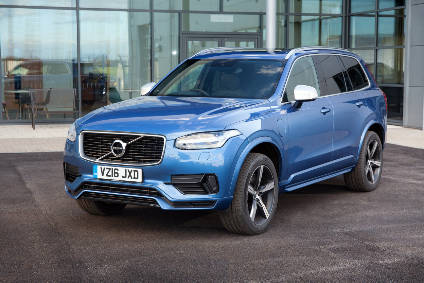
Volvo’s transformation into a maker of sometimes high-priced luxury cars continues: it’s now possible to pay £64,000 (US$84,813) for the T8 version of the XC90. Is this PHEV worth that sort of money?
The company spoke openly about its aim to become a true premium image brand over three years ago. The old XC90 was starting to look dated but the replacement model was yet to be revealed, so this was quite a leap of faith. A bit like what FCA is trying to do right now with its ambitions for Alfa Romeo.
Many were the doubters who couldn’t see the stylish and sensible brand evolving out of an image akin to H&M into something upmarket, like, perhaps, Tiger of Sweden. This does seem to be taking place, with margins rising as strongly as worldwide sales. Even with the traditional down month of August in Sweden for Volvo, global deliveries were up nine percent to 32,826, this being the 15th consecutive monthly sales rise. Year to date, the global total is 331,070, a gain of 10%.
While the XC60 remains the company’s number one model with sales of 96,386 during the first eight months, the XC90 is closing on the second best performer. With deliveries of 58,491 (versus just 14,039), the big SUV should overtake the V40 & V40 Cross Country (61,449) later in 2016, to judge by the pace at which its sales are rising.
That the T8 version of the XC90 is selling well globally – including even in the US where buyers tend not to be too enthusiastic about plug-in hybrids – shows just how successful Volvo’s gamble on dumping all engines with more than four cylinders has been.
The T8 has a supercharged and turbocharged 2.0-litre petrol engine, one electric motor and an eight-speed torque converter automatic gearbox. Volvo claims that the supercharger fills in the bottom end of the power range to give the engine a big, naturally-aspirated feel, while the turbocharger kicks in when the airflow builds up. The electric motor on the rear wheels provides immediate torque. In practice it’s convincing. Never do you sense that this is a small capacity engine struggling to cope with the size and weight of the vehicle it is powering.

US Tariffs are shifting - will you react or anticipate?
Don’t let policy changes catch you off guard. Stay proactive with real-time data and expert analysis.
By GlobalDataSPA, Volvo’s larger vehicles platform, was designed to be future proof well into the next decade, so the XC90 will be by no means the only PHEV or even EV using this architecture. The company has already stated that it is developing a pure EV due on sale by 2019.
The compact size of the 1,969cc engine means an electric motor can be fitted in the front or rear of SPA vehicles, while the battery pack is located in the centre of the car. And even though there is four-wheel drive, there’s no transmission hump getting in the way of where a middle rear passenger wants to place their feet, while the third row is also roomy enough for two adults to be comfortable on a long journey – myself and six friends had a weekend away and everybody came back very impressed by the Volvo’s comfort, and its silence even at high speeds.
Like many other PHEVs, with this one you can leave the powertrain to its own devices and it will choose the combination of power source. Or, press a button to save stored energy for later, or else choose to drive using the batteries alone.
The T8 has combined power of 407hp (320 from the engine + 87 from the motor) and torque of 640Nm (400 + 240) but unless you hammer the right pedal, somehow it doesn’t feel that powerful. When you do press down hard on the throttle pedal, acceleration is remarkable for a big, four-cylinder SUV, zero to 62mph taking just 5.6 seconds. Yet, and here is why the T8 is proving to be so popular in European markets, CO2 is only 49g/km.
This top of the range variant is marketed by Volvo as a so-called ‘Twin Engine’ vehicle and carries a T8 badge on its tailgate to denote the PHEV powertrain.
Normal driving is conducted in the default hybrid mode, which sees the engine sending drive to the front wheels and the motor powering the back axle. By pressing a button, the driver can switch to emission-free city driving on electric power and then, when needed, immediately revert to the combined capacity of the petrol engine and electric motor.
Graeme was already written at length about other XC90s, so I won’t repeat those details. He will also have more to say about Volvo’s expanding electrification program next month in a piece on the latest V60 Twin Engine.
The T8 is to me the best Volvo yet. Regular readers will know I was a huge fan of the V60 Polestar but the Twin Engine XC90 is even better – somehow the engineering feels more sophisticated, which that mix of fuel economy, CO2 average and acceleration echoes. If only Volvo would give it an exhaust synthesiser to make it sound sexier, in the way that Audi does with its V6 diesels – how about making it emit the same burble as the Yamaha 4.0-litre petrol V8 did in the original XC90?



